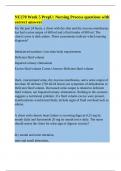NU270 Week 5 PrepU: Nursing Process questions with
correct answers
For the past 24 hours, a client with dry skin and dry mucous membranes
has had a urine output of 600 ml and a fluid intake of 800 ml. The
client's urine is dark amber. These assessments indicate which nursing
diagnosis?
Imbalanced nutrition: Less than body requirements
Deficient fluid volume
Impaired urinary elimination
Excess fluid volume Correct Answer-Deficient fluid volume
Dark, concentrated urine, dry mucous membranes, and a urine output of
less than 30 ml/hour (720 ml/24 hours) are symptoms of dehydration or
Deficient fluid volume. Decreased urine output is related to deficient
fluid volume, not Impaired urinary elimination. Nothing in the scenario
suggests a nutritional problem. If a fluid volume excess were present,
manifestations would most likely include signs of fluid overload such as
edema.
A client with chronic heart failure is receiving digoxin 0.25 mg by
mouth daily and furosemide 20 mg by mouth twice daily. The nurse
should assess the client for what sign of digoxin toxicity?
dry mouth and urine retention.
taste and smell alterations.
,nocturia and sleep disturbances.
visual disturbances. Correct Answer-visual disturbances.
Digoxin toxicity may cause visual disturbances (e.g., flickering flashes
of light, colored or halo vision, photophobia, blurring, diplopia, and
scotomata), central nervous system abnormalities (e.g., headache,
fatigue, lethargy, depression, irritability and, if profound, seizures,
delusions, hallucinations, and memory loss), and cardiovascular
abnormalities (e.g., abnormal heart rate, arrhythmias). Digoxin toxicity
doesn't cause taste and smell alterations. Dry mouth and urine retention
typically occur with anticholinergic agents, not inotropic agents such as
digoxin. Nocturia and sleep disturbances are adverse effects of
furosemide — especially if the client takes the second daily dose in the
evening, which may cause diuresis at night.
Hinkle, J.L., and Cheever, K.H. Brunner & Suddarth's Textbook of
Medical-Surgical Nursing, 14th ed., Philadelphia: Wolters Kluwer,
2018, Chapter 29: Management of Patients With Complications from
Heart Disease, Digitalis, p. 826.
Chapter 29: Management of Patients With Complications from Heart
Disease - Page 826
The nurse is caring for the client following surgery for a urinary
diversion. The client refuses to look at the stoma or participate in its
care. The nurse formulates a nursing diagnosis of:
,Deficient knowledge: stoma care
Situational low self esteem
Disturbed body image
Anticipatory grieving Correct Answer-Disturbed body image
The client is exhibiting defining characteristics of disturbed body image.
Hinkle, J.L., and Cheever, K.H. Brunner & Suddarth's Textbook of
Medical-Surgical Nursing, 14th ed., Philadelphia: Wolters Kluwer,
2018, Chapter 55: Management of Patients With Urinary Disorders,
Improving Body Image, p. 1645.
Chapter 55: Management of Patients With Urinary Disorders - Page
1645
The client with chronic open-angle glaucoma is receiving timolol
(Timoptic) eye drops. Which evaluation finding would indicate to the
nurse the treatment is working?
Decrease in nausea and vomiting
Intraocular pressure 15 mm Hg
Halos around lights
Reduced peripheral vision Correct Answer-Intraocular pressure 15 mm
Hg
, Timoptic is a beta-blocker that is used topically to decrease the flow rate
of aqueous humor in the eye. As flow rate decreases, the intraocular
pressure decreases. IOP of 12 to 21 mm Hg is within normal range.
Reduced peripheral vision, halos around lights, and blurred vision are all
symptoms of open-angle glaucoma. Nausea and vomiting are more
likely to occur with acute angle-closure glaucoma.
Hinkle, J.L., & Cheever, K.H., Brunner & Suddarth's Textbook of
Medical-Surgical Nursing, 14th ed., Philadelphia, Wolters Kluwer,
2018.
The nurse taking care of a patient evidencing signs of shock empties the
urinary catheter drainage bag after her 12-hour shift. The nurse notes an
indicator of renal hypoperfusion. What is the relevant urinary output for
this condition?
500 mL
400 mL
600 mL
300 mL Correct Answer-300 mL
An indicator of renal hypoperfusion is a urinary output of less than 30
mL/hr. An output of 300 mL in 12 hours is less than 30 mL/hr, which is
indicative of oliguria.
Hinkle, J. L., Cheever, K. H. Brunner & Suddarth's Textbook of
Medical-Surgical Nursing , 14th ed Philadelphia: Wolters Kluwer




